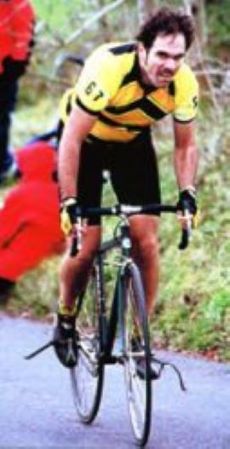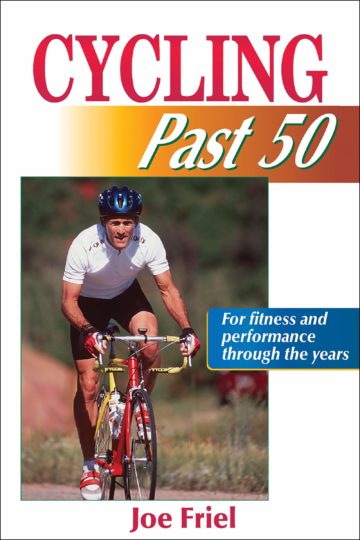Part 2. Are You Past 50, or Just Feeling Past It?
When we get past 50 years of age, we begin to cycle more slowly and every hill seems to get steeper. Unfortunately, the clock never stops ticking, and it is October again. My birth certificate tells me that this month I am another year older.
I only wish that when I was 50, I had known what I know now. I had never heard of the term “sarcopenia,” or details of the effects that it has on every one of us with each passing year. Now with an aging population, there is a considerable amount of research into sarcopenia – what causes it, and more importantly what we can do to slow down the inevitable loss of vitality as the years pass by.

Just to remind you of some worrysome statistics from last month’s introduction to this topic, the following data shows the age-related decline in performance, based on world record times for running the marathon. Note how the decline accelerates with age. Cycling being an endurance sport, similar declines can be expected.
Decline per decade – Aged 40 to 50 was 8.3%
Decline per decade – Aged 50 to 60 was 13.5%
Decline per decade – Aged 60 to 70 was 14.0%
Of course these were world class athletes but it happens to all of us, so start to take action now before you get older, and health and fitness have noticeably declined.
And another source ( Sarcopenia of Aging: Loss of Muscle Size and Strength | Dr. Gabe Mirkin on Health (drmirkin.com ) has more to say about this subject and identifies some of the many related research papers, such as, and I quote:
“After age 65, up to 50 percent of North Americans suffer from sarcopenia that is significant enough, to limit their daily activities ( J. Am. Geriatr. Soc, 2004;52:80-85).
By age 70, the rate of muscle loss nearly doubles to 15 percent per decade, markedly increasing risk for disability and disease (Am J Epidemiol, 1998;147(8):755-763; Nutr Rev, May 2003;61(5 Pt 1):157-67; Muscles Ligaments Tendons J, Oct-Dec, 2013;3(4):346-350).
The people who lose the most muscle are usually the ones who die earliest.”
If that isn’t a wakeup call, I don’t know what is!
So What is Sarcoponia?
Sarcopenia (from the Greek, meaning vanishing flesh), it the term used for the age related, loss of lean muscle mass. And don’t forget that your heart is a muscle! And your lungs are activated by one – the diaphragm.
Perhaps a simple explanation (of what is a much more complex subject) might help.
All muscles are made up of thousands of individual muscle fibres. The larger muscles, such as those powering our legs, have hundreds of thousands of them.

The muscle fibres are of three different types: slow-twitch – (type I) which fire slowly and have great endurance, and fast-twitch – (types IIa and IIb) – which fire explosively when we need power.
These different types of muscle fibres are used progressively. When we ride at a moderate conversational pace, we are using our slow-twitch fibres. When we ride harder, e.g. faster or climbing a hill, in addition to our slow-twitch fibres, we recruit our fast-twitch IIa fibres. When we exercise really hard, such as sprinting or charging up a hill, we then also bring into action our fast-twitch IIb fibres.
Due to the aging process, our muscle fibres progressively atrophy/die and we gradually produce less power. As a consequence, we older cyclists develop a tendency towards less strenuous activity. For example, we become less competitive, our average cycling speed drops, we probably avoid some of the more challenging hills, etc. Then the old saying – “use it or lose it” – comes to the fore. As we make less and less use of our more powerful, type IIa and type IIb muscle fibres, they die off more rapidly than our more used type I, endurance muscle fibres. And so with aging we become weaker.
This is not just theory. It has been established in numerous research studies, that an appropriate training programme is the most effective means by which we can counter the effects of sarcopenia.
“In a review of 37 studies of men and women over 60, researchers found that a proper exercise program enlarged and strengthened the muscles in 93 percent of the participants (Osteoporosis International, March 1, 2017). In only 14 percent of the participants was there any additional benefit from nutritional changes.”
A Proper Exercise Programme.
On the basis of – “use it or lose it” – the answer would appear to be to increase exercise intensity, and so keep our more powerful, type IIa and type IIb muscle fibres more active, rather than let them wither away and die. And that has proven to be the case – when applied appropriately.
The most appropriate forms of exercise have been shown to be resistance exercise, much favoured by our cycling champions!

But perhaps that might not be appropriate for some of us! A simpler and easier way might be to start off with body weight exercises.

The second most effective form of exercise is H.I.I.T – high intensity interval training. This is recommended by some cycling coaches for competitive cyclists, instead of weight training. But most coaches recommend both, because doing both types of exercise are more beneficial – if done appropriately. Which this would not be, for most of us more senior citizens!

Whilst Resistance Training, especially weight training, is primarily to boost muscular strength, H.I.I.T is primarily used to increase cardio – vascular performance – that is, to increase the amount of oxygen that we can use when exercising. In it’s simplest form, and when starting an H.I.T programme, a session can easily be done in less than an hour – including a warm up, and cool down at the end of the session.
So what is “appropriate” exercise for us 50 and over cyclists?
Well there is no single, simple answer. We are all different and unique individuals, but a very knowledgeable and experienced coach has come up with guidelines for all of us. In his best selling book for serious cyclists, The Cyclist’s Training Bible, it is defined thus: ” an athlete should do the least amount of properly timed, specific training that brings about continual improvement”.,
Notice it says “the least amount”. Especially as we age, we need more rest and recovery time. We are also much more prone to injuries. So slow but consistent progress is the way forward for long term, continued improvement.
The author of The Cyclist’s Training Bible” has more recently brought out a book along the same lines, but specifically for the over 50s. So what better for a read, during the long winter evenings that start at the end of this month?
For some more very useful information, and advice on what types of exercise are best for us to perform, see what another knowledgeable writer has to say, here: Slowing Loss of Bone and Muscle Strength with Aging | Dr. Gabe Mirkin on Health (drmirkin.com)
I hope that you all, not just the over 50s, see the sense in what Dr Mirkin has to say about the benefits of both Interval Training and Resistance Training. Cycling is a great cardio exercise, and for our legs. But it does little for our upper body and thus our over all fitness, which resistance training does.
Des.

